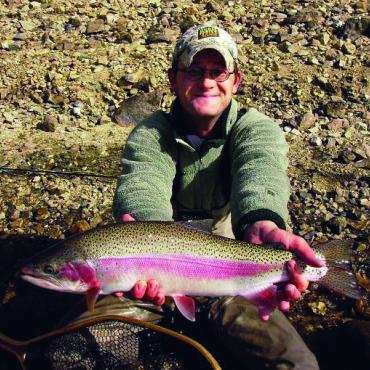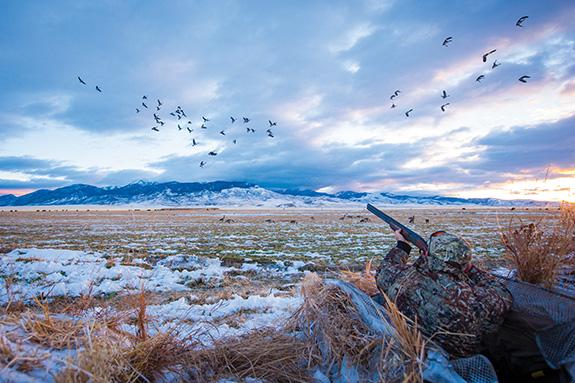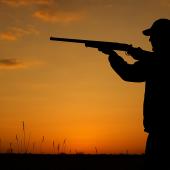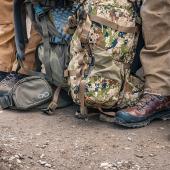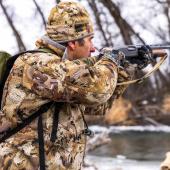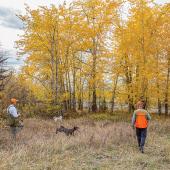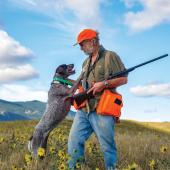Geese Lightning
The great V in the sky.
A flock of geese cutting through the sky is a sight to remember. A goose hit by a well-placed blast of triple-B shot, crashing through a makeshift blind and knocking my kid brother sprawling, is a sight I’ll never forget. My brother and I came to waterfowl hunting with very little tutelage other than what we could glean from sporting magazines and library books. Growing up on a ranch west of Bozeman, we found the flocks of geese covering our stubble fields to be a constant source of distraction from chores and homework. Through bad decisions, many missed shots, and numerous pre-dawn canoe launches, we managed to put a handful of Canadas and a couple of snow geese on the table. Our waterfowl hunting was always geared toward harvest; if all we managed to roust up was a single goldeneye, we were stoked. However, once that first fat goose crashed through that pile of sticks and brush we’d hidden behind, we became goose hunters.
Habitat
Geese of most species like wide-open water and wide-open spaces. Think lakes rather than ponds, 100-acre fields as opposed to 10-acre lots, and big rivers rather than creeks. The Yellowstone, Missouri, and Bighorn are good examples. Not only does the sheer volume of water rolling down these rivers keep them relatively ice-free well into the late season, the landscapes that these rivers flow through are often cultivated for grain crops, providing much-needed forage and resting areas for migrating birds headed south. If a section of land or stretch of water looks tough to approach and lacks cover, chances are it’s a good spot to hunt geese.
Behavior
The most common and most hunted species of goose in Montana is the Canada goose. While it isn’t uncommon to have a chance at a snow goose, snows usually quickly land, rest for a bit, and are then on their way. Snows are most often encountered on bright clear days high up in the stratosphere making a racket as they fly over the state making a B-line for easier living around the Gulf of Mexico. White-fronted geese, or speckle-bellies, can also be encountered while hunting, but they’re rare. Since Canadas are most common, focus your efforts on this species.
Among the things that make geese harder to hunt than ducks is that they tend to fly much higher, and in larger flocks. Trying to pry a flock of birds out the sky with a handful of decoys and a call is next to impossible. Concentrate on small flocks, and if possible, plan your hunts for days when the cloud ceiling is low, and the weather is less than comfortable. Avoid the temptation to pass-shoot at flocks, or singles that haven’t locked in for a landing. Passing birds may look close but are usually out of range, and because of their flight speed, birds are more likely to be wounded rather than killed. Keep a close eye on what waterfowl are doing and where they’re gathering, even in the off-season. Something as simple as an afternoon walk with the dog can be a great chance to do some recon for future goose-hunting outings.
Gear
Goose hunters can literally spend thousands of dollars on decoy spreads alone. Hardcore goose hunters will often be in the fields and marshes well before sunup laying out hundreds of decoys. This strategy can be amazingly effective, and if you and your group of hunting buddies are willing to spend the money on a menagerie of shells, silhouettes, and full-body decoys, plus layout blinds, as well as a mountain of other gear, you’ll most likely bring home several limits in the coming season. This is of course provided one happens to have access to a piece of ground whereon to place these decoys and blinds. A more economical approach is to invest in a dozen or so high-quality floating decoys and spread these out among your duck blocks, or set them up in marshes or fields where geese have been seen in the pre-season.
Geese are highly social, and highly vocal. They respond very well to calls—even those of a novice caller—provided the set-up is right. A determined and lucky neophyte can fool even the wariest goose. There are numerous calls on the market and some are incredibly expensive. Shy away from the cheaper plastic models, as well as the high-end, artisan varieties. For practicality purposes, a quality wooden call can be purchased for under 50 bucks. The best way to get comfortable with a goose call is to practice with it often.
A long-barreled and tightly-choked 12-gauge is a great choice for a goose gun. Many dyed-in-the-wool goose hunters swear by 16-gauges, and they work great, but a morning of shooting this big gauge can leave one sore-shouldered and beat up. I like pump guns; other hunters are enamored with double-barrels. Due to the extreme weather conditions we encounter in this area, especially during the late season, even the best auto-loader can jam up. BB and triple-B shot are arguably the best choice for goose hunting, as geese are large. Shot smaller than #2 is never recommended.
Blind location and set-up are crucial when hunting all waterfowl, but especially geese. In addition to netting, burlap, or other blind materials, try using as much natural material as possible. Geese will often make several passes over a set-up looking for anything that seems amiss—if something does, they’ll fly on. When shooting at geese, it pays to exercise discipline—avoid the urge to blast away at the first passer-by. Instead, try to get the shots in as close as possible, ideally when the goose is locked on and coming in to land.
Clothing for goose hunting should be versatile. Dress and go afield prepared for changing weather conditions and remember that any goose outing is likely to be wet and muddy. Outer layers should be windproof and waterproof, with the proper color and camouflage pattern for your chosen hunting area.
Regs
Like all migratory birds, the U.S. Fish and Wildlife Service sets goose seasons. Remember that in addition to your Montana waterfowl license, you’ll also need a federal waterfowl stamp. Generally speaking, waterfowl season in Montana begins in early October and ends around the second week in January. Since Montana is bisected by two flyways, the Central and the Pacific, pay close attention to current regulations and note that variations may exist between the two.

